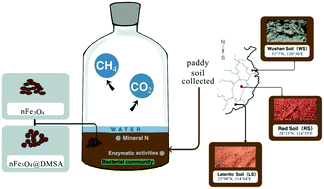Fe3O4 nanoparticles affect paddy soil microbial-driven carbon and nitrogen processes: roles of surface coating and soil types†
Abstract
Magnetic Fe3O4 nanoparticles (nFe3O4) are the most widely used nanomaterials and are inevitably introduced to soils. To overcome particle agglomeration, nFe3O4 are often coated with protective agents. However, scarce information has addressed the impacts of surface coating of nFe3O4 on biochemical processes and microbial properties in soil. In this study, a laboratory incubation experiment was employed to reveal the response of gas production, mineral N content, enzymatic activities and soil bacterial community to nFe3O4 and meso-2,3-dimercaptosuccinic acid coated nFe3O4 (nFe3O4@DMSA) in three representative paddy soils in China, i.e. lateritic soil (LS), Wushan soil (WS), and red soil (RS). The results showed that nFe3O4@DMSA, rather than nFe3O4, influenced these parameters profoundly, with varying effects in the soil types. Specifically, in RS nFe3O4@DMSA, rather than nFe3O4, promoted the CH4 production, soil NH4-N concentration, and soil enzymatic activities of β-xylanase (BX) and β-N-acetylglucosaminidase (NAG), but decreased the CO2 production and β-glucosidase (BG) activity. By contrast, in LS and WS nFe3O4@DMSA led to increases in CO2 emission, soil NH4-N content, and BG, BX, and NAG activities, but a decrease in CH4 production. Data from 16S rRNA gene sequencing showed the varying responses to the nanoparticles in terms of soil bacterial taxa and putative functional groups. The methanogens and the N-fixation group had strong affinities with the CH4 production and NH4-N content, respectively. Geobacter was closely related to the CH4 production in all soils. Anaeromyxobacter, Azospirillum, and Burkholderia–Caballeronia–Paraburkholderia had close relationships with the N-fixation group/NH4-N content in LS, WS and RS, respectively. Collectively, nFe3O4@DMSA changed the microbial-driven biochemical process in the soils, depending on the soil types. Caution should be paid to the complex interaction between the soil matrix and nanoparticle types for better management of nanoparticles in future.



 Please wait while we load your content...
Please wait while we load your content...